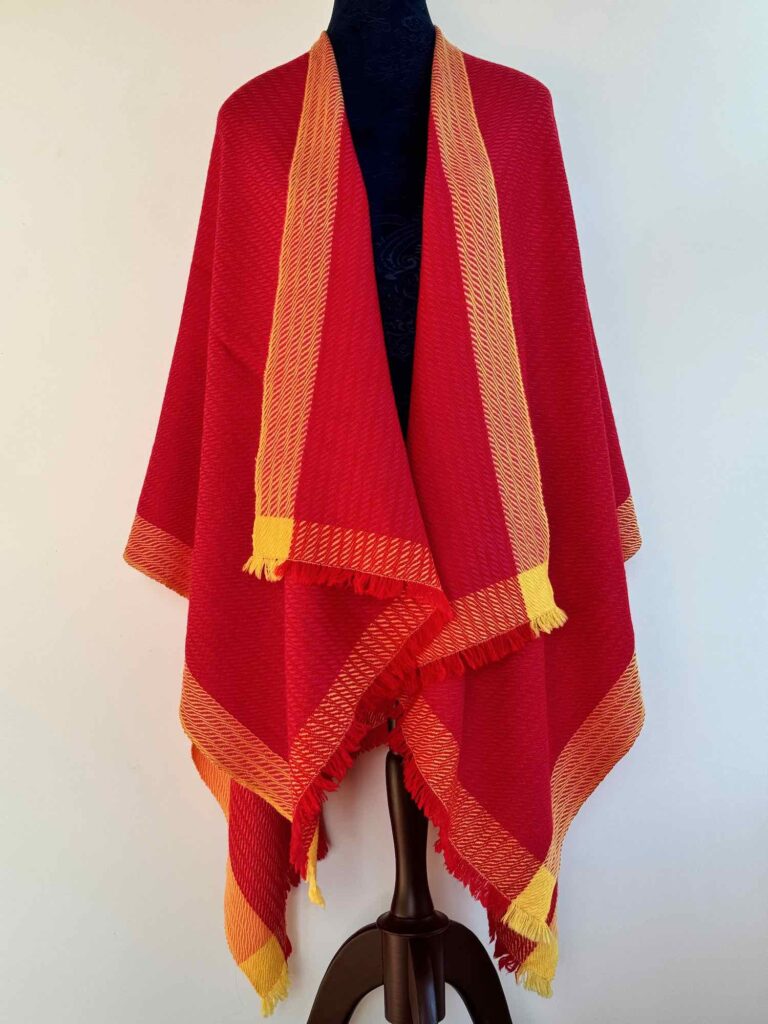I tied overhand knots in the end of the warp and lashed the warp to the warp beam. I then found the warp back onto the warp beam, rethreaded the heddles (1,2,3,4,5,6,7,8,1,3,5,7,1,3,5,7… from R-L) and resleyed the reed at 30epi (3 ends per dent). I had 54 pattern repeats and 2 floats on each side – 864 ends @30epi = 73cm on loom.Overhand knots were tied in the “front” ends of the warp and the warp lashed to the apron rod. This allowed me to begin weaving again with the smallest loss of warp length possible. Two tabby treadles were tied up with shafts 1,4,6,7 & 2,3,5,8.
Once the loom was ready, I wove header rows to spread the warp evenly and hemstitched in yellow. I wove the yellow border (~5.5cm, this squares the side border) and measured an 80cm length of cotton tape. This was used to measure the coloured weft section so that the 4 sections would be the same size. Each time I wound the warp on, I pinned the tape further along the woven cloth. I wove the 80cm of new melon (salmon), then 80cm of lipstick (bright pink/magenta) followed by ~5.5cm of yellow border and hemstitching. I left a 5cm gap and repeated the whole process.
BUT when I was almost a the end of the final section, I realised that I was going to run out of warp before I had woven the full amount of fabric. So I wove as close to the warp end as I could – the yellow border picks were all woven with the assistance of hand-manipulation of shafts to ensure a clear shed. You can see from the table below that the final section of fabric (lipstick) is about 7cm short.
After cutting the finished fabric from the loom, I cut the two pieces of fabric apart. To ensure that the fringe between pieces was even, I pinned the two rows of hemstitching together and cut the fringe at the fold. I then pinned the other two hemstitch ends to these cut ends and trimmed the other 2 fringes so that they were all the same length. This didn’t entirely work as the end fringes are a little scalloped, but they are pretty good.
The fabric was then hand washed in warm water, spun in the machine on medium speed, loose ends trimmed, hot pressed on wool setting and hung to dry.
| Section | Pre-wash (width x length; cm) | Post-wash (width x length; cm) |
| New melon 1 | 68.5 x 81.25 | 65.5 x 75.25 |
| Lipstick 1 | 68 x 81.25 | 65.5 x 75.25 |
| New melon 2 | 68 x 80 | 65 x 75 |
| Lipstick 2 | 67.5 x 74 | 64 x 68 |
The purchaser of the finished item came to look at the fabric. We decided to stitch the centre back seam so that new melon (salmon) would be the back of the garment and lipstick (bright pink/magenta) would be the front.
Accordingly, I stitched the halves together with “Ancient stitch” (p31 “Finishes in the Ethnic Tradition” by S. Baizerman & K. Searle, 2019).
Finished weight = 422g
The purchaser tried on the finished garment. We decided to lower the back join by ~10cm. This makes the weft colour change sit more on top of the shoulders and means that the back doesn’t hang so far down – the front and back are more similar in length.
After making this change, the purchaser was very happy. The finished garment is BEAUTIFUL. Great colours, lovely hand and drape; very soft fabric.









